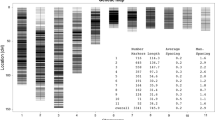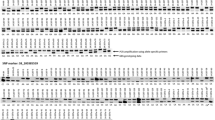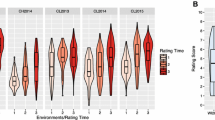Abstract
Downy mildew (caused by Pseudoperonospora humuli) causes significant losses in hop (Humulus lupulus L.) cone yield and quality, and potential crown death. Breeding for resistance has proved difficult presumably because of the highly quantitative nature of genetic control over expression. The objective of this study was to utilize multiple environments to ascertain downy mildew resistance and identify molecular markers linked to resistance. A widely segregating population, ‘Teamaker’ × USDA 21422M was inoculated and evaluated for downy mildew in field studies (Corvallis, OR and Yakima, WA) and a greenhouse study. Next generation sequencing using an Illumina HiSeq 2000 was performed on this population. Resulting reads were imported into UNEAK TASSEL 4.0 pipeline for processing and SNP-calls. Approximately 120,435 unfiltered SNP markers were identified and of these markers, 9081 high quality markers chosen for association analysis. Data analyses for field studies in OR and WA were performed separately using trait values averaged across blocks. Differential trait associated marker sets were identified across each physical environment with partial overlap between field environments. Mixed linear model analyses identified 39 markers (21 from OR, 10 from WA and eight overlapping) associated with response to downy mildew infection (p < 1 × 10−4). The most significant 17 markers were validated using high-resolution melting curve analysis and the resistant allele identified. Four SNP markers, along with the respective “resistant” alleles, were classified as highly selective for resistance (model adjusted R2 = 0.437). Multiplexing studies are underway to develop a simple PCR tool for selecting downy mildew resistance.
Similar content being viewed by others
Abbreviations
- GBS:
-
Genotyping-by-sequencing
- GWAS:
-
Genome-wide association study
- SNP:
-
Single nucleotide polymorphism
- NGS:
-
Next generation sequencing
References
Benjamini Y, Hochberg Y (1995) Controlling the false discovery rate: a practical and powerful approach to multiple testing. J R Stat Soc, Ser B 57 (1):289–300. MR 1325392
Bradbury PJ, Zhang Z, Kroon DE, Casstevens TM, Ramdoss Y, Buckler ES (2007) TASSEL: software for association mapping of complex traits in diverse samples. Bioinformatics 23:2633–2635
Buckler ES, Holland JB, Bradbury PJ, Acharya C, Brown P et al (2009) The genetic architecture of maize flowering time. Science 325:714–718
Cerenak A, Satovic Z, Javornik B (2006) Genetic mapping of hop (Humulus lupulus L.) applied to the detection of QTLs for alpha-acid content. Genome 49:485–494
Cerenak A et al (2009) Identification of QTLs for alpha acid content and yield in hop (Humulus lupulus L.). Euphytica 170:141–154
Chee HY, Nelson ME, Grove GG, Eastwell KC, Kenny ST, Klein RF (2006) Population biology of Psuedoperonospora humuli in Oregon and Washington. Plant Dis 90:1283–1286
Dunn OJ (1961) Multiple comparisons among means. J Am Stat Assoc 56(293):52–64. doi:10.1080/01621459.1961.10482090
Durrant WE, Dong X (2004) Systemic acquired resistance. Ann Rev Phytopathol 42:185–209. doi:10.1146/annurev.phyto.42.040803.140421
Elshire RJ, Glaubitz JC, Sun Q, Poland JA, Kawamoto K et al (2011) A robust, simple genotyping- by-sequencing (GBS) approach for high diversity species. PLoS One 6(5):e19379. doi:10.1371/journal.pone.0019379
Ganal MW, Durstewitz G, Polley A, Bérard A, Buckler ES et al (2011) A large maize (Zea mays L.) SNP genotyping array: development and germplasm genotyping, and genetic mapping to compare with the B73 reference genome. PLoS One 6(12):e28334. doi:10.1371/journal.pone.0028334
Gent DH, Ocamb CM (2009) Predicting infection risk of hop by Pseudoperonospora humuli. Phytopathology 99:1190–1198
Gent DH, Ocamb CM, Farnsworth JL (2010) Forecasting and management of hop downy mildew. Plant Dis 94:425–431
Gudrun HR, Kent JO, Wittwer CT (2007) High-resolution DNA melting analysis for simple and efficient molecular diagnostics. Pharmacogenomics 8(6):597–608. doi:10.2217/14622416.8.6.597
Henning JA (2006) The breeding of hop. In: Bamworth C (ed) Brewing: new technologies. Woodhead Publishing Limited, Cambridge
Henning JA, Townsend MS, Mahaffee WF, Kenny S, Haunold A (2004) Registration of Newport hop. Crop Sci 44:1018–1019
Henning JA, Haunold A, Townsend MS, Gent DH, Parker TB (2008) Registration of ‘teamaker’ hop. J Plant Reg 2008(2):13–14. doi:10.3198/jpr2007.02.0105crc
Henning JA, Townsend MS, Gent DH, Bassil N, Matthews P, Buck E, Beatson R (2011) QTL mapping of powdery mildew susceptibility in hop (Humulus lupulus L.). Euphytica 180:411–420. doi:10.1007/s10681-011-0403-4
Huang X, Wei X, Sang T, Zhao Q, Feng Q, Zhao Y, Li C et al (2010) Genome-wide association studies of 14 agronomic traits in rice landraces. Nat Genet 42:961–967. doi:10.1038/ng.695
Johnson DA, Alldredge JR, Allen JR (1994) Weather and downy mildew epidemics of hop in Washington State. Phytopathology 84:524–527
Kearsey MJ, Luo ZW (2003) Mapping, characterization and deployment of quantitative trait loci. In: Newbury HJ (ed) Plant molecular breeding. CRC Press, Boca Raton, pp 1–29
Koie K, Inaba A, Okada Y, Kaneko T, Ito K (2005) Construction of the genetic linkage map and QTL analysis on hop (Humulus lupulus L.). Acta Hort 668:59–66
Liew M, Pryor R, Palais R, Meadows C, Erali M, Lyon E, Wittwer C (2004) Genotyping of single-nucleotide polymorphisms by high-resolution melting of small amplicons. Clin Chem 50:1156–1164
Lu F, Lipka AE, Glaubitz J, Elshire R, Cherney JH et al (2013) Switchgrass genomic diversity, ploidy, and evolution: SNP discovery protocol. PLoS Genet 9(1):e1003215. doi:10.1371/journal.pgen.1003215
Mancino LE (2013) Investigating the evolutionary relationship of Pseudoperonospora cubensis and P. humuli through phylogenetic and host range analyses. Honors Thes. University of Oregon, Eugene
McAdam EL, Freeman JS, Whittock SP, Buck EJ et al (2013) Quantitative trait loci in hop (Humulus lupulus L.) reveal complex genetic architecture underlying variation in sex, yield and cone chemistry. BMC Genom 14:360. doi:10.1186/1471-2164-14-360
Mitchell MN, Ocamb CM, Grünwald NJ, Mancino LE, Gent DH (2011) Genetic and pathogenic relatedness of Pseudoperonospora cubensis and P. humuli. Phytopathology 101:805–818
Mitchell-Olds T (2010) Complex trait analysis in plants. Genome Biol 11:113–115. doi:10.1186/gb-2010-11-4-113
Neve RA (1991) Hops. Chapman and Hall, London
Parker T (2007) Investigations of hop downy mildew through association mapping and observations of the oospore. PhD Dissertation, Oregon State University. http://hdl.handle.net/1957/6223. Accessed 30 Nov 2015
Perneger TV (1998) What’s wrong with Bonferroni adjustments? Br Med J 1998(316):1236. doi:10.1136/bmj.316.7139.1236
Poland JA, Rife TW (2012) Genotyping-by-sequencing for plant breeding and genetics. Plant Genome 5(3):92–102
Royle DJ, Kremheller HTH (1981) Downy mildew of the hop. In: Spencer DM (ed) The downy mildews. Academic Press, New York, pp 395–419
Runge F, Thines M (2012) Reevaluation of host specificity of the closely related species Pseudoperonospora humuli and P. cubensis. Plant Dis 96:55–61
Runge F, Choi YJ, Thines M (2010) Phylogenetic investigations in the genus Pseudoperonospora reveal overlooked species and cryptic diversity in the P. cubensis species cluster. Eur J Plant Pathol 29:135–146
Seigner E, Lutz A, Radic-Miehle H, Seefelder S, Felsenstein FG (2004) Breeding for powdery mildew resistance in hop (Humulus lupulus L.): strategies at the hop research center, Huell, Germany. Acta Hort 668:19–30
Seipp MT, Pattison D, Durtschi JD, Jama M, Voelkerding KV, Wittwer CT (2008) Quadruplex genotyping of F5, F2, and MTHFR variants in a single closed tube by high-resolution amplicon melting. Clin Chem 54:108–115
Sherman EL, Nkrumah JD, Moore SS (2009) Whole genome single nucleotide polymorphism associations with feed intake and feed efficiency in beef cattle. J Anim Sci 88(1):16–22
Untergrasser A, Cutcutache I, Koressaar T, Ye J, Faircloth BC, Remm M, Rozen SG (2012) Primer3—new capabilities and interfaces. Nucleic Acids Res 40(15):e115
Visscher PM, Brown MA, McCarthy MI, Yang J (2012) Five years of GWAS discovery. Am J Hum Genet 90(1):7–24. doi:10.1016/j.ajhg.2011.11.029
Waugh R, Marshall D, Thomas B, Comadran J, Russell J, Close T et al (2010) Whole-genome association mapping in elite inbred crop varieties. Genome 53(11):967–972. doi:10.1139/G10-078
Acknowledgments
Special thanks are extended to Edward Buckler (USDA-ARS, Cornell University) and his laboratory and members of Cornell’s Institute for Genomic Diversity (Sharon Mitchell, Charlotte Acharya and Theresa Fulton) for all the helpful advice and suggestions that enabled this research to be successful. This research was funded through USDA-ARS CRIS project # 5358-21000-040-00D as well as funding support from the Hop Research Council (www.hopresearchcouncil.org).
Author information
Authors and Affiliations
Corresponding author
Rights and permissions
About this article
Cite this article
Henning, J.A., Gent, D.H., Twomey, M.C. et al. Genotyping-by-sequencing of a bi-parental mapping population segregating for downy mildew resistance in hop (Humulus lupulus L.). Euphytica 208, 545–559 (2016). https://doi.org/10.1007/s10681-015-1600-3
Received:
Accepted:
Published:
Issue Date:
DOI: https://doi.org/10.1007/s10681-015-1600-3




